Adjaruli Khachapuri is a boat-shaped bread from Georgia (in Russia), that holds melted salty cheese and a soft cooked egg or sometimes two in the middle. The name Khachapuri has its origins in the words “Khacho” meaning cottage cheese/ cheese curd”, and “Puri” meaning bread. From what I understand, the Georgians often eat it as a snack or for lunch. I enjoyed it for breakfast and dinner.
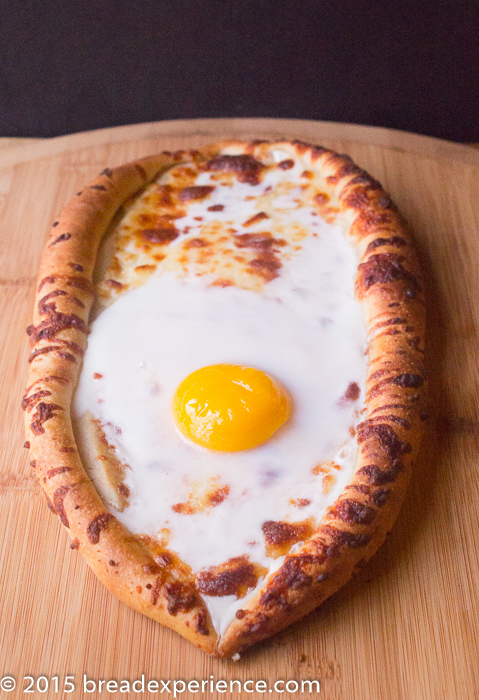
Aparna of My Diverse Kitchen chose Adjaruli Khachapuri as the bread of the month for the Bread Baking Babes. I decided to make a somewhat traditional version with an egg on top because I’ve been wanting to try a fried egg on pizza for a while. My version wouldn’t be considered traditional because first of all, I made it with spelt and secondly, it is fermented with kefir milk and includes an overnight rest in the refrigerator.
A bit of history about Adjaruli Khachapur from Aparna:
Some people like to call it a Georgian Pizza Pie, but I think that’s insulting to both the Pizza and the Khachapuri. There are similarities but they’re really two distinctly individual dishes to my mind.
Khachapuri is considered one of Georgia’s national dishes and each region of Georgia makes a variety of it. So much so that the Tbilisi State University supposedly developed a “Khachapuri Index” to measure inflation based on how much it costs to make one Imeretian Khachapuri!
Acharuli/ Adjaruli Khachapuri comes from Adjara, the mountain region of Georgia’s Black Sea coast which is known for its dairy products. In Georgia, this bread is often filled with a cheese called “Sulguni” which is a salty sheep’s milk cheese, Imeretian cheese, or a blend of both.
If you would like to make an egg-free Khachapuri, you can leave the egg out and use just the cheese and something else. It may not be authentic Georgian Khachapuri but it would be like a Greek Peinirli. A Greek Peinirli (from the Turkish work Peynir for cheese) is very much like the Khachapuri and has its origins in the recipes brought by immigrants who lived near the Black Sea over a century back.
Traditionally Acharuli/ Adjaruli Khachapuri does not require anything else on the side and is usually served on its own. As soon as the bread comes out of the oven, a large blob of butter is added to the top. The melted butter is mixed in with the runny egg and melty cheese with a knife. You break off the end of the “boat” first and the sides later, dipping them in the oozy, melty mixture in the middle and popping it into your mouth.
Aparna’s notes about the dough and shaping the boat:
This dough can be made with a pre-ferment, or just mix the dough ingredients, and proof in the fridge overnight for improved flavour.
When shaping the “boat” make sure the sides that are rolled up are sealed well and when you pinch together the dough to form the “ends” of the boat. You might want to use a little water to moisten the dough to seal it well. Otherwise, it might open out in the oven.
Videos showing how Adjaruli Khachapuri is made:
Part 1 – https://www.youtube.com/watch?v=wdvtIsNpwlU
Part 2 – https://www.youtube.com/watch?v=8GYdjwxgIiE
Here’s a video that shows “The correct way to eat Adjaruli Khachapuri”
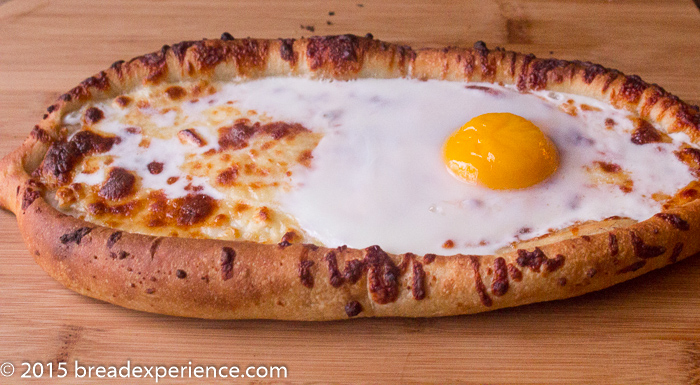
Acharuli/ Adjaruli Khachapuri (A Boat Shaped Georgian Egg & Cheese Bread)
Adapted from Saveur Magazine’s Recipe
Ingredients:
For the Dough:
- 3/8 tsp instant yeast
- 1/2 tsp sugar
- 2/3 cup kefir milk
- 1 tbsp. olive oil
- 2 – 2 1/4 cups all-purpose spelt flour, plus more for dusting
- 1 tsp salt
For the Filling:
- 1 1/2 cups grated/ shredded Mozzarella
- 1 1/2 cups crumbled feta cheese
- 2 eggs (or any other topping of choice)
For topping after baking:
4 tbsp. unsalted butter, cubed (optional, I didn’t use it)
Method:
In a large bowl, whisk together 1 3/4 cups flour, yeast, sugar, and salt. Combine the kefir milk and olive oil and pour over the dry ingredients. Mix with a Danish dough whisk or a wooden spoon until combined. Fold and turn the dough until everything comes together into a smooth and somewhat loose elastic dough.
Form the dough into a ball. Transfer the ball of dough to a well-oiled bowl, turning it so it is coated all over. Loosely cover and let the dough rest for 20 – 30 minutes. Then fold the dough. Recover and let it rise for 1 hour. Fold the dough again after 30 minutes; and again after 1 hour. Place the dough back in the bowl, and cover it tightly with plastic wrap. Place the bowl in the refrigerator to cold-ferment overnight.
The next day, take the dough out of the refrigerator and knead it a little bit to degas it. Let it warm up about 20 to 30 minutes. You may need to add some more flour. I added about 1/2 cup at this point because the dough was fairly sticky. Knead the dough some more; then let it rest for 1 hour.
Place a pizza stone, or a baking sheet on a rack in the lower third of the oven. Preheat oven to 250C (500F).
Combine the cheeses in a bowl and set aside. Deflate the dough and divide it into two halves. Working with one piece at a time, roll it out to a rectangle about 10” thick and 1/8” thick on a piece of lightly floured parchment. This makes it easier to transfer the dough to your baking sheet.
Roll the long sides in a bit curving them inwards at the ends and seal well (with a little water) or the edges will open up during baking. Then bring the edges close and pinch together on both ends to form a boat-like shape.
Again, make sure the ends are sealed well. Transfer the “boats” to the baking sheet, but if you’re going to bake them directly on the pizza stone just omit this step.
Dock the centre “well” area. I pricked it with a fork. Fill with half of the cheese mixture so it is a little higher than the edges of the dough “boat”. Repeat with the other half of the dough and bake them for about 12 to 15 minutes until the Khachapuri is golden brown.
Take the breads out of the oven, gently crack an egg on each bread without breaking the yolk, and return them to the oven. Bake for another 3 to 4 minutes till the egg is set.
Take the Adjaruli Khachapuri out, and place a couple of cubes (2 tbsp) butter on each. Optional.
Serve them hot. It helps to wait for about 10 minutes before eating them so you don’t burn your mouth!
This recipe serves 4 to 6 people.
Here is the crust of the first one. I baked these on two different days. I baked the first one a little too long, but I enjoyed it. It reminded me of toast with an egg on top. I let the egg set a little longer on this one so for the second one, I left it a little more runny. I think it’s better runny because you can dip the bread in it.
I waited a couple of days before making the second one. They were both good, but you might want to adjust the baking time depending on how crispy you like the crust.
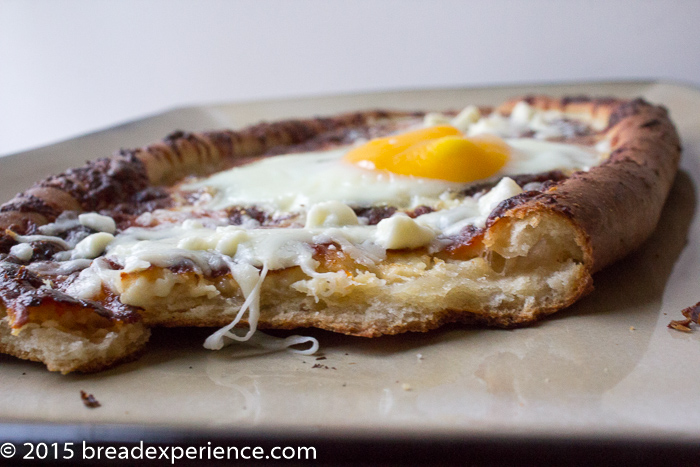
A cheesy and eggy bite of Adjaruli-Khachapuri made with spelt and kefir milk.
Aparna is the host kitchen for January for the Bread Baking Babes. Details on how to participate in this month’s bake can be found on Aparna’s post.
Happy Baking!
Cathy

– Karen
blog from OUR kitchen – Elizabeth
Bread Experience – Cathy
All Roads Lead to the Kitchen – Heather
Judy’s Gross Eats – Judy
Karen’s Kitchen Stories – Karen
My Diverse Kitchen – Aparna
My Kitchen In Half Cups – Tanna
Notitie Van Lien – Lien
Thyme for Cooking – Katie (Bitchin’ Bread Baking Babe Bibliothécaire)
Life’s a Feast – Jamie
Living in the Kitchen with Puppies – Natashya
Ilva Beretta Food Photography – Ilva
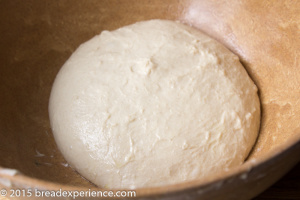
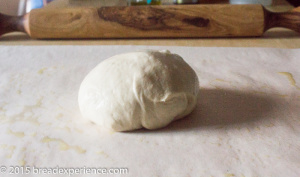
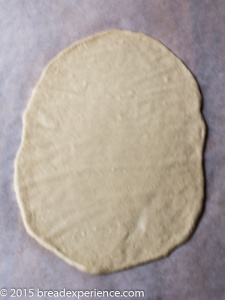
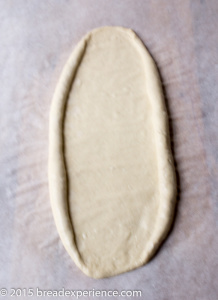
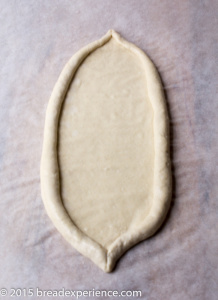
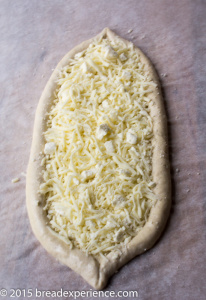
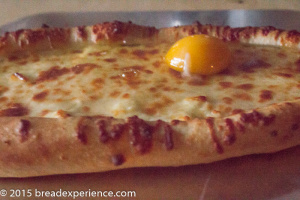
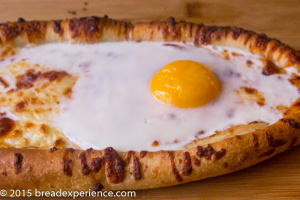
Elizabeth says
Even though there is that runny egg yolk staring out at me, your khachapuri looks fabulous. I particularly like the coracle shape of your boat. And the side view showing the crumb and melty bit of cheese is wonderful.
As for your use of kefir, at least one of the recipes I looked at when searching called for kefir in the dough. So I’m thinking your version may be the most traditional.
Cathy says
Elizabeth, you really should try the runny egg on this bread. I wasn’t sure about it either, but I’m glad I tried it.
Heather | All Roads Lead to the Kitchen says
Mmmm, that looks delicious – love the shot of the ripped bread!
Baking Soda says
Lovely! It’s been a few days but when I see yours I could have another go right now! And… I see now that I forgot to dock the bottom. Next time!
MyKitchenInHalfCups says
I love the rest in the fridge! But more, I love your bread. This really is one to enjoy again and again. Seeing yours this morning makes me want to bake it again.
Aparna says
I love the changes you make every month to the breads, and this one looks perfect. I’m another one of those wary of “runny” eggs and haven’t really dared to try one so far. 🙂